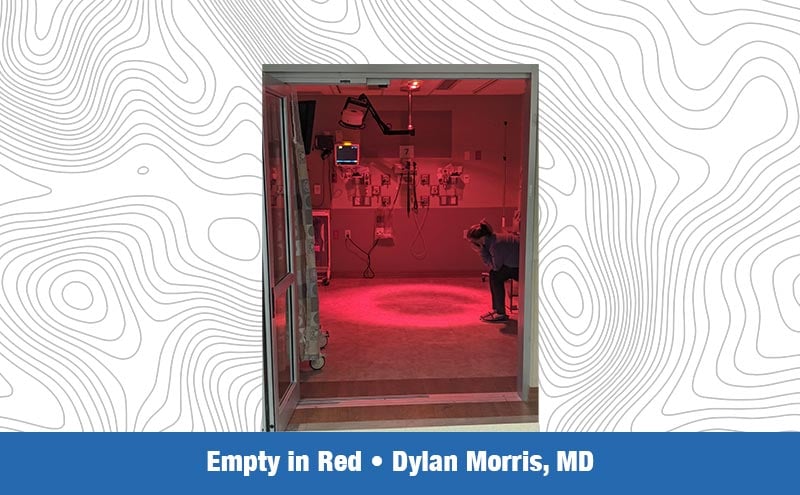Artists Among Us: ACEP's 2021 Annual Report features original art submitted to the 2020 and 2021 HeART of Emergency Medicine Galleries. This photo, “Empty in Red” by Dylan Morris, MD, was "taken just before 6 a.m. and seems to reflect much of the hardship of emergency medicine."
ACEP believes all emergency physicians and health care workers should feel safe in the emergency department, and we’re working toward that goal. We’ve had some key developments on the regulatory and advocacy fronts.
ACEP Helps The Joint Commission Develop New Standards
On Jan. 1, 2022, The Joint Commission (TJC) started enforcing new requirements to guide hospitals in developing strong workplace violence prevention programs. ACEP participated in the expert workgroup that developed the standards, which specify:
- Workplace Assessment: Hospitals must conduct an annual worksite analysis related to their workplace violence prevention program, and based upon findings, leadership must take action to mitigate or resolve the workplace violence safety and security risks.
- Monitoring: Hospitals must establish a process(es) for continually monitoring, internally reporting, and investigating workplace hazards, such as safety and security incidents involving patients, staff, or others within its facilities, including those related to workplace violence.
- Education and Training: Hospitals must provide training, education, and resources to leadership, staff, and licensed practitioners to address prevention, recognition, response, and reporting of workplace violence.
- Response Plans: Hospital response plans will specify policies and procedures to prevent and respond to workplace violence, processes to report incidents to analyze incidents and trends, and processes for follow-up and support to affected victims and witnesses.
View ACEP's full fact sheet about these TJC standards.
Concerned about workplace violence protections at your hospital? Please reach out to ACEP to let us know. We can connect you with appropriate resources, and your story can help to inform and enhance ACEP’s advocacy for stronger workplace protections.
Workplace Violence Bill Passes the House
In April 2021, the House of Representatives passed the bipartisan Workplace Violence Prevention for Health Care and Social Service Workers Act (H.R. 1195). This bipartisan legislation directs OSHA to issue standards for employers to implement workplace violence prevention plans that would protect health care and social service workers from assaults.
ACEP had a very active role in the development and support of this bill, and our ED violence data was referenced in the Findings section of the bill as it was introduced. We continue to lobby for its passage through the Senate.
Raising Awareness
ACEP’s public relations team continues to highlight the ED violence problem through ACEP’s “No Silence on ED Violence” campaign with the Emergency Nurses Association and media outreach. Our 2018 survey of 3,539 emergency physicians found that nearly half of participants have been assaulted while working in the emergency department, and roughly 97% of those assaults were committed by patients. These stats are often referenced by the media, and ACEP works with these outlets to help flesh out the stories with quotes from ACEP members or additional supporting documentation, such as peer-reviewed studies on the topic. These are just a few of the articles ACEP’s PR team supported and amplified in 2021:
- “Health Workers Once Saluted as Heroes Now Get Threats” AP News, Sept. 2021
- “Time for Change: Violence is Not Part of the Job in Healthcare” Relias Media, Sept. 2021
- “Violence Against Healthcare Workers is a Growing Problem” Forbes, Aug. 2021
- “Emergency Departments are a Dangerous Workplace” MedPage Today, July 2021
Annals Study Brings Awareness to the Issue
Studies and statistics are another way to raise public awareness of the ED violence problem, as evidenced by a June 2021 article in Annals of Emergency Medicine. “A Qualitative Study of Resident Physician and Health Care Worker Experiences of Verbal and Physical Abuse in the Emergency Department” authored by Lauren B. Querin, MD, Gary L. Beck Dallaghan, PhD, and Christina Shenvi, MD, PHD, helped draw fresh media attention to this important topic.
Making a Statement
The EM Practice Committee developed a new policy statement “Safer Working Conditions for Emergency Department Staff” that addresses the importance of leadership promotion of safety, interior and exterior facility infrastructure, safety planning, reporting and training, written and posted behavioral standards, and the availability of equipment to prevent workplace injury.






